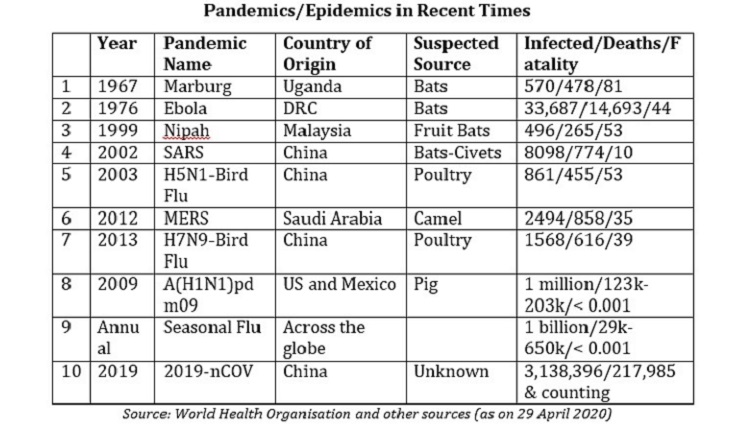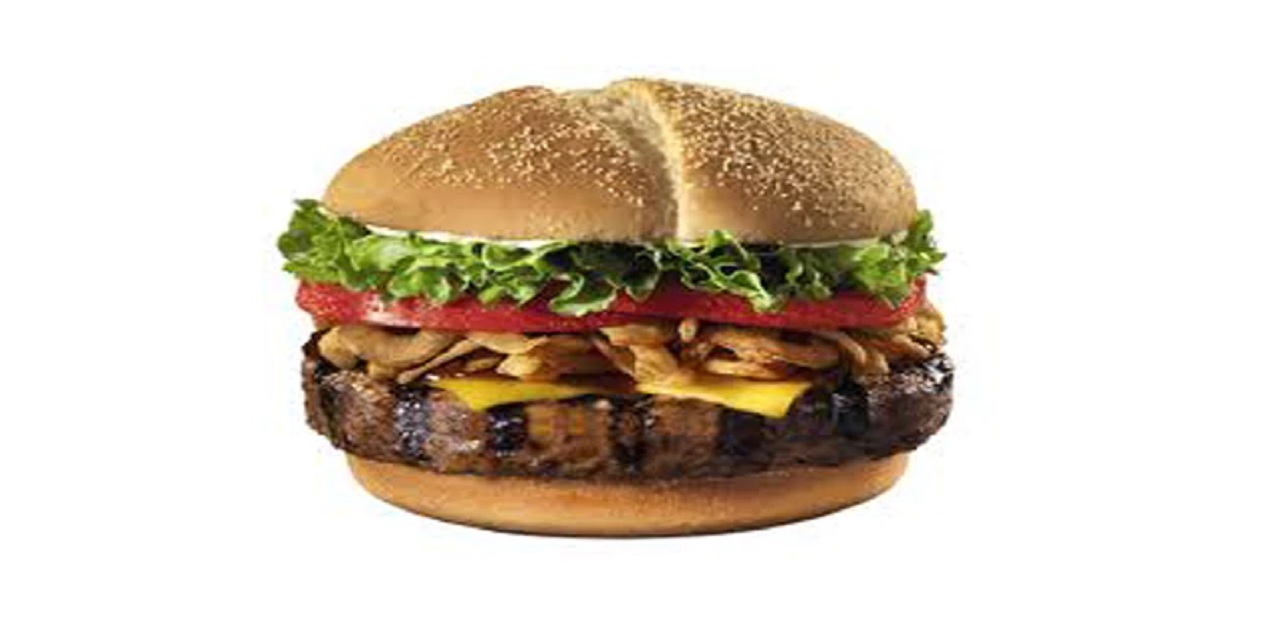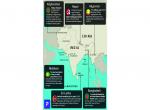Three consignments of African Pangolin scales have been recently seized at ports in two Southeast Asian countries. On the first day of April, port authorities in Port Kelang, Malaysia confiscated six tons of the contraband packed in a shipping container.1 Soon thereafter, two large consignments (over 12 tons each) of African Pangolin scales were seized by custom authorities in Singapore.2 Pangolins are the most trafficked animal in the world and according to the Wildlife Justice Commission, most of this contraband originates in Africa particularly from Nigeria.3
Pangolins along with bats have been identified as the probable source or likely intermediary host of the SARS-CoV-2 virus or the novel coronavirus COVID-19. This belief is gaining greater credence keeping in mind there have been several instance of pandemics (see table below) associated with birds and animals as the source.

The table above clearly establishes ‘animal-human connection and this is further corroborated by a study Mapping of Poverty and Likely Zoonoses4 Hotspots, which notes that “around 60% of all human diseases and around 75% of emerging infectious diseases are zoonotic” and that “exploding global demand for livestock products means the problem is likely to get worse.”5
Meat-Climate Change Connection
Animal meat and marine life has been part of human nourishment since ages. These continue to be part of the menu on the dining table at home, fine dining restaurants, food courts and many other outlets. Chefs across the globe are presenting gourmet recipes and offering customers spectacular dishes. Mankind has not only savored different varieties of meat but has valued it as a rich and an important source of protein supplement given that grain, pulses and vegetables are not sufficient to provide for human protein needs. The preference for meat in human diet has therefore continued and its consumption is quite promising.
The World Health Organisation estimates that world’s livestock sector is witnessing phenomenal growth due to “population growth, rising incomes and urbanization”6 Furthermore, meat production has increased worldwide by “nearly 5 times in the second half of the 20th century, and the amount eaten per person doubled. By 2050 meat consumption could increase by as much as another 160 percent.”7
However, there is now a growing pessimism about consumption of meat. According to the Food and Agriculture Organization (FAO) of the United Nations, nearly half of the global agriculture production is consumed by livestock and just 37 per cent is for humans. It takes about 7 kilogram of grain in dry weight to produce 1 kilogram of live weight for bovine; around 4 kilograms for 1 kilogram of live weight for pigs, and for poultry it is just over 2 kilograms; and one pound of eggs require 477 gallons of water.8
It is also widely acknowledged that massive deforestation and loss of habitat are closely associated with large scale animal rearing and farming. Furthermore, one of the major contributors of Green House Gases (GHG) is the livestock sector. Meat and cattle milk production result in 65 per cent anthropogenic GHG which is equivalent of about 4.6 giga tons carbon dioxide; pork, poultry and eggs contribute about ten percent each; and cattle feed production and processing, enteric fermentation from ruminants, manure storage and processing are other closely associated producers of GHG.9
Vegetarian and Vegan
Humans are omnivores i.e. Vegetarians and Meatarians10 and both plants and meat provide nourishment. Consumption of both foods has found reference in the history of human existence and survival. But “most anthropologists agree that early humans would have eaten a predominantly plant-based diet”.11 In the western world, the well-known mathematician Pythagoras (570 BC-495 BC) promoted ‘Pythagorean diet’,12 and Plato (428 BC-348 BC) described a vegetarian diet as ‘divinely ordained’; 13 however, the term vegetarian became popular during the 1800s.
In India, vegetarianism can be traced back to Vedic times and is framed in the social-cultural-religious constructs. There is indirect reference to the practice of vegetarianism (non-killing of animals) in Mahabharata, Anushasana Parva 115.33 - “The sins generated by violence curtail the life of the perpetrator. Therefore, even those who are anxious for their own welfare should abstain from meat-eating”. And in Atharva Veda 19.48.5 “Those noble souls who practice meditation and other yogic ways, who are ever careful about all beings, who protect all animals, are the ones who are actually serious about spiritual practices.”14
Some Indians also take Sattvik food which has emphasis in the Chhāndogya Upaniṣhad and it is argued that Satvik food “purifies the mind and becomes part of our pure consciousness. “āhāraśhuddhausattvaśhuddhiḥ” (7.26.2) states people with pure mind prefer pure sattvik food.”15 Likewise, Jainism which has roots in India, advocates nonviolence and promotes vegetarian diet for its followers. However, only green-vegetables can be consumed but root vegetables (potatoes, onions, roots and tubers) are forbidden “because such root vegetables are considered Ananthkay i.e. one body, but containing infinite lives”.16
Another food preference/choice called Vegan diet is fast gaining popularity particularly among the Western countries. This diet excludes all animal-derived ingredients including eggs and dairy products. It is not prompted by any religious practice; but there are at least three issues which have made this diet popular; first is human health and a number of scientific studies have confirmed the benefits of plant-based diet that reduces the risk of chronic illnesses and lifestyle diseases such as diabetes, cardiovascular diseases, and obesity-related conditions; second is about environment and the international communityhas come to realize the critical need to reduce GHG emissions; and third is the growing understanding among the humans of the sustainability of plant based diet.17
Arrival of Mock Meat
The latter has given rise to a number of ‘fake meat’ products and ‘non-meat’ alternatives such vegan meats, cheeses, milks, and other products which serve the needs of both vegetarians as well as the vegans and they need not make dramatic changes to their eating habits. Fake meat is not new and an array of processed vegan products have been produced and consumed in many regions of the world. The traditional Chinese fake meats are made from tofu and mushrooms, and in India, Soy products (‘chaap’), and Kebabs made of Lotus Stem, Jackfruit, raw Banana, Yam, Beetroot, and Mushroom have similar texture, are popular among vegetarians. Similarly, plant based milk from soy, coconut and almond is gaining popularity, but it is limited to those with disposable income or those who suffer from lactose intolerance.
Post-COVID-19 Food Habits
COPVID-19 is surely going to bring about some changes in people’s choices and preferencesfor food due to fear of contracting animal-bird vectored diseases. This is not to suggest that meat, poultry and fish will go off the table; instead consumers can be expected to be more selective in food habits and choices, and sidestep meat for vegetable based diet to avoid any health issues.
The global market for “meat is expected to grow at a CAGR of roughly 3.4% over the next five years; it will reach 3,80,800 million US$ in 2024, from 3,22,800 million US$ in 2019,” with Europe and the USA region in the lead. 18 China will retain its position as world’s biggest consumer of meat (retail value equal to roughly US$170 billion annually); and its ‘free from meat’ food market, including plant-based products’ would be worth nearly US$ 12 billion by 2023, up from just under US$10 billion in 2018.19 A number of homegrown alternatives are being produced and according to a study “more than 60% of Chinese consumers intend to eat more fruit & vegetables, though consumers do not perceive these to deliver protein; and 39% are reducing their meat intake, which is coming mostly from pork, now in decline for 3 years. Dairy, fish/seafood and beef, though, are on the rise.”20
It is generally believed that India is a country of vegetarians given that its per capita consumption of meat is very low; yet nearly 70 % of India’s population eat meat and associated foods;21 but bulk of it is in the form of poultry (65%) because it is cheap and does not attract cultural or religious taboos.
In India there have been instances in the past of bird related flues such as the Avian Influenza. In recent times, since January 2020 when COVID-19 was detected in India, there have been at least three incidents of outbreak of Avian Influenza in Kerala, Odisha and Karnataka necessitating deployment of special squads to cull poultry. Although the World Health Organization says, “Avian influenza viruses normally spread between birds. However, some viruses have been found to infect humans. When avian influenza infects humans, symptoms may range from mild upper respiratory infection (fever and cough) to severe pneumonia, acute respiratory distress syndrome (difficulty breathing), shock and even death,”22 Therefore, any Avian Influenza is a major concern for India.
Vegan diet or Veganism among Indians is still in its infancy but is slowly becoming popular. Some outlets are now offering vegan sweets and desserts, and fashion houses are considering vegan clothing, vegan leather to replace animal hide for footwear, and numerous other such products are being slowly embraced. According to a study by the US-based Good Food Institute that promotes plant-based alternatives to animal products, “63% of Indian consumers were ‘very or extremely likely to purchase plant-based meat regularly,’ followed closely by Chinese consumers at 62% while US lags behind at 33%.”23
Concluding Thoughts
At the heart of the current pandemic i.e. COVID-19 is an invisible virus that incubated in either a Pangolin or in a bat that led to animal-human transmission. We are now told that humans must live with COVID-19 till such time an effective vaccine is developed and successfully administered on humans and make them coronavirus-free. Meanwhile the World Health Organisations has observed that we are still long way from winning the fight against this virus and must continue to observe and practice physical distancing measures.
Amid this pessimistic outlook, COVID-19 could be an opportune moment to sit back and think about our dietary preferences and food habits. Although going meatless is an attractive option for people in India, it would need to be balanced against jobs and livelihoods particularly poultry industry (total broiler meat market size is over INR 85,000 crore and table egg production is more than INR 45,000 crore).24 Closely associated is the issue of crop diversification (high-protein crops25), cropping systems and agricultural production, including supply chain management.
It would also be important to explore new-style ‘plant-based meat like alternatives’ and these would appeal to vegetarians, non-vegetarians and vegans alike. These alternatives could become mainstream as compared to ‘cultured meat’ or ‘laboratory-made meat’ given that it would contain cells of a live animal.
Endnotes
- “Malaysian authorities seize record 6 tons of African pangolin scales”, https://news.mongabay.com/2020/04/malaysian-authorities-seize-record-6-tons-of-african-pangolin-scales/ (accessed 27 April 2020).
- “Second 12-tonne haul of pangolin scales seized in less than a week”, https://www.straitstimes.com/singapore/second-12-tonne-haul-of-pangolin-scales-seized-in-less-than-a-week?fbclid=IwAR0vwlZEYCUU45b9B5ZfTRJMtC6sQ6Gb7yirBoOXFP_YWRjz4YeZ7_2WFi8 (accessed 27 April 2020).
- “Nigeria to Vietnam via Singapore is the popular supply chain route and are linked to almost 70% of pangolin scale seizures. For more details see “Scaling up: The Rapid Growth in the Industrial Scale Trafficking of Pangolin Scales 2016-2019”, https://wildlifejustice.org/wp-content/uploads/2020/02/WJC_PangolinReport_2020_Executive-Summary.pdf (accessed 27 April 2020).
- Zoonoses are diseases transmissible between animals (domestic and wildlife) and humans.
- Delia Grace &Mutua, (et al) “Mapping of poverty and likely zoonoses hotspots”, Zoonoses Project, 1-119, 2012.
- “Availability and changes in consumption of animal products”, https://www.who.int/nutrition/topics/3_foodconsumption/en/index4.html(accessed 25 April 2020).
- “Tons of Meat eaten”, https://www.theworldcounts.com/challenges/consumption/foods-and-beverages/world-consumption-of-meat (accessed 28 April 2020).
- Cited in Vijay Sakhuja, “Greenhouse Gases and Dietary Changes”, https://www.thepeninsula.org.in/2019/07/22/green-house-gases-and-dietary-changes/(accessed 27 April 2020).
- Ibid.
- Someone who consumes meat, especially as a major source of protein.
- “Beans and Greens: The History of Vegetarianism”, https://www.history.com/news/beans-and-greens-the-history-of-vegetarianism (accessed 28 April 2020).
- Pythagoras followed lacto-vegetarian, i.e. fruits, vegetables, cereals, nuts, legumes and dairy minimally and avoid chicken, egg and seafood. See “Pythagorean Diet Erases 95% of Diseases!”
https://moco-choco.com/2013/10/21/pythagorean-diet-erases-95-of-diseases/ (accessed 28 April 2020). - “History of Vegetarianism”, https://vegetarian.procon.org/history-of-vegetarianism/ (accessed 27 April 2020).
- “4 Things about Hinduism and Vegetarianism”,https://www.hinduamerican.org/blog/4-things-about-hinduism-and-vegetarianism/ (accessed 27 April 2020).
- “What is Sattvic diet? https://theyogainstitute.org/what-is-sattvic-diet/ (accessed 27 April 2020).
- “Jain vegetarianism”, https://en.wikipedia.org/wiki/Jain_vegetarianism (accessed 29 April 2020).
- Cited in Vijay Sakhuja, “Greenhouse Gases and Dietary Changes”, https://www.thepeninsula.org.in/2019/07/22/green-house-gases-and-dietary-changes/(accessed 27 April 2020).
- “Global Meat Market 2019 by Manufacturers, Regions, Type and Application, Forecast to 2024”, https://www.360researchreports.com/global-meat-market-14105665 (accessed 28 April 2020).
- “Coronavirus has put plant protein back on the menu for China”, https://www.weforum.org/agenda/2020/04/plants-protein-coronavirus-safety-china (accessed 28 April 2020).
- “Protein: A Chinese Perspective”, https://www.mpi.govt.nz/dmsdocument/29150/send (accessed 28 April 2020).
- “India’s Meat Consumption To Increase By 2027”, https://www.databaaz.in/indias-meat-consumption-to-increase-by-2027/ (accessed 28 April 2020).
- “Avian influenza?”,https://www.who.int/features/qa/avian-influenza/en/ (accessed 28 April 2020).
- “This food tech startup wants to dish out vegan meat for you”, https://economictimes.indiatimes.com/small-biz/startups/features/this-food-tech-startup-wants-to-dish-out-vegan-meat-for-you/articleshow/73719883.cms?utm_source=contentofinterest&utm_medium=text&utm_campaign=cppst(accessed 28 April 2020).
- “Covid-19 lockdown has severely hit the poultry industry with Q4 being the worst quarter: ICRA”, Read more at:
https://economictimes.indiatimes.com/news/economy/agriculture/covid-19-lockdown-has-severely-hit-the-poultry-industry-with-q4-being-the-worst-quartericra/articleshow/75351861.cms?utm_source=contentofinterest&utm_medium=text&utm_campaign=cppst (accessed 28 April 2020). - “Indian Food Nutrition Chart for grains, fruits and vegetables”, http://www.fitjog.com/nutrition-charts/indian-food-nutrition-charts.php(accessed 28 April 2020).
(The paper is the author’s individual scholastic articulation. The author certifies that the article/paper is original in content, unpublished and it has not been submitted for publication/web upload elsewhere, and that the facts and figures quoted are duly referenced, as needed, and are believed to be correct). (The paper does not necessarily represent the organisational stance... More >>
Image Source: https://www.indiatoday.in/technology/story/lab-grown-beef-burger-scientists-mark-post-london-cattle-stem-cells-172653-2013-08-03;











Post new comment